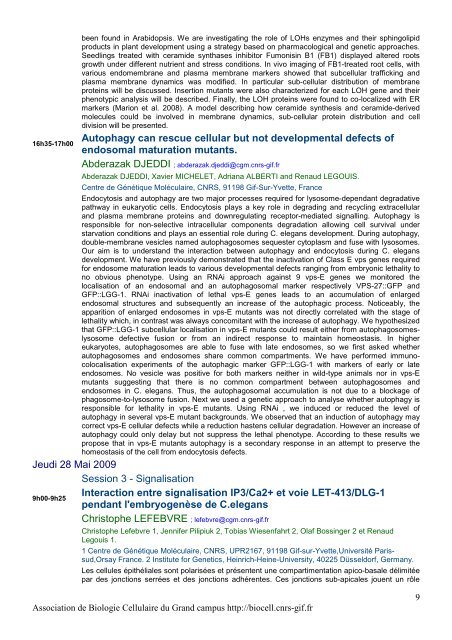Dynamique Cellulaire - Développement - Association de Biologie ...
Dynamique Cellulaire - Développement - Association de Biologie ...
Dynamique Cellulaire - Développement - Association de Biologie ...
Create successful ePaper yourself
Turn your PDF publications into a flip-book with our unique Google optimized e-Paper software.
16h35-17h00<br />
been found in Arabidopsis. We are investigating the role of LOHs enzymes and their sphingolipid<br />
products in plant <strong>de</strong>velopment using a strategy based on pharmacological and genetic approaches.<br />
Seedlings treated with cerami<strong>de</strong> synthases inhibitor Fumonisin B1 (FB1) displayed altered roots<br />
growth un<strong>de</strong>r different nutrient and stress conditions. In vivo imaging of FB1-treated root cells, with<br />
various endomembrane and plasma membrane markers showed that subcellular trafficking and<br />
plasma membrane dynamics was modified. In particular sub-cellular distribution of membrane<br />
proteins will be discussed. Insertion mutants were also characterized for each LOH gene and their<br />
phenotypic analysis will be <strong>de</strong>scribed. Finally, the LOH proteins were found to co-localized with ER<br />
markers (Marion et al. 2008). A mo<strong>de</strong>l <strong>de</strong>scribing how cerami<strong>de</strong> synthesis and cerami<strong>de</strong>-<strong>de</strong>rived<br />
molecules could be involved in membrane dynamics, sub-cellular protein distribution and cell<br />
division will be presented.<br />
Autophagy can rescue cellular but not <strong>de</strong>velopmental <strong>de</strong>fects of<br />
endosomal maturation mutants.<br />
Ab<strong>de</strong>razak DJEDDI ; ab<strong>de</strong>razak.djeddi@cgm.cnrs-gif.fr<br />
Ab<strong>de</strong>razak DJEDDI, Xavier MICHELET, Adriana ALBERTI and Renaud LEGOUIS.<br />
Centre <strong>de</strong> Génétique Moléculaire, CNRS, 91198 Gif-Sur-Yvette, France<br />
Endocytosis and autophagy are two major processes required for lysosome-<strong>de</strong>pendant <strong>de</strong>gradative<br />
pathway in eukaryotic cells. Endocytosis plays a key role in <strong>de</strong>grading and recycling extracellular<br />
and plasma membrane proteins and downregulating receptor-mediated signalling. Autophagy is<br />
responsible for non-selective intracellular components <strong>de</strong>gradation allowing cell survival un<strong>de</strong>r<br />
starvation conditions and plays an essential role during C. elegans <strong>de</strong>velopment. During autophagy,<br />
double-membrane vesicles named autophagosomes sequester cytoplasm and fuse with lysosomes.<br />
Our aim is to un<strong>de</strong>rstand the interaction between autophagy and endocytosis during C. elegans<br />
<strong>de</strong>velopment. We have previously <strong>de</strong>monstrated that the inactivation of Class E vps genes required<br />
for endosome maturation leads to various <strong>de</strong>velopmental <strong>de</strong>fects ranging from embryonic lethality to<br />
no obvious phenotype. Using an RNAi approach against 9 vps-E genes we monitored the<br />
localisation of an endosomal and an autophagosomal marker respectively VPS-27::GFP and<br />
GFP::LGG-1. RNAi inactivation of lethal vps-E genes leads to an accumulation of enlarged<br />
endosomal structures and subsequently an increase of the autophagic process. Noticeably, the<br />
apparition of enlarged endosomes in vps-E mutants was not directly correlated with the stage of<br />
lethality which, in contrast was always concomitant with the increase of autophagy. We hypothesized<br />
that GFP::LGG-1 subcellular localisation in vps-E mutants could result either from autophagosomeslysosome<br />
<strong>de</strong>fective fusion or from an indirect response to maintain homeostasis. In higher<br />
eukaryotes, autophagosomes are able to fuse with late endosomes, so we first asked whether<br />
autophagosomes and endosomes share common compartments. We have performed immunocolocalisation<br />
experiments of the autophagic marker GFP::LGG-1 with markers of early or late<br />
endosomes. No vesicle was positive for both markers neither in wild-type animals nor in vps-E<br />
mutants suggesting that there is no common compartment between autophagosomes and<br />
endosomes in C. elegans. Thus, the autophagosomal accumulation is not due to a blockage of<br />
phagosome-to-lysosome fusion. Next we used a genetic approach to analyse whether autophagy is<br />
responsible for lethality in vps-E mutants. Using RNAi , we induced or reduced the level of<br />
autophagy in several vps-E mutant backgrounds. We observed that an induction of autophagy may<br />
correct vps-E cellular <strong>de</strong>fects while a reduction hastens cellular <strong>de</strong>gradation. However an increase of<br />
autophagy could only <strong>de</strong>lay but not suppress the lethal phenotype. According to these results we<br />
propose that in vps-E mutants autophagy is a secondary response in an attempt to preserve the<br />
homeostasis of the cell from endocytosis <strong>de</strong>fects.<br />
Jeudi 28 Mai 2009<br />
Session 3 - Signalisation<br />
Interaction entre signalisation IP3/Ca2+ et voie LET-413/DLG-1<br />
9h00-9h25<br />
pendant l'embryogenèse <strong>de</strong> C.elegans<br />
Christophe LEFEBVRE ; lefebvre@cgm.cnrs-gif.fr<br />
Christophe Lefebvre 1, Jennifer Pilipiuk 2, Tobias Wiesenfahrt 2, Olaf Bossinger 2 et Renaud<br />
Legouis 1.<br />
1 Centre <strong>de</strong> Génétique Moléculaire, CNRS, UPR2167, 91198 Gif-sur-Yvette,Université Parissud,Orsay<br />
France. 2 Institute for Genetics, Heinrich-Heine-University, 40225 Düsseldorf, Germany.<br />
Les cellules épithéliales sont polarisées et présentent une compartimentation apico-basale délimitée<br />
par <strong>de</strong>s jonctions serrées et <strong>de</strong>s jonctions adhérentes. Ces jonctions sub-apicales jouent un rôle<br />
<strong>Association</strong> <strong>de</strong> <strong>Biologie</strong> <strong>Cellulaire</strong> du Grand campus http://biocell.cnrs-gif.fr<br />
9


